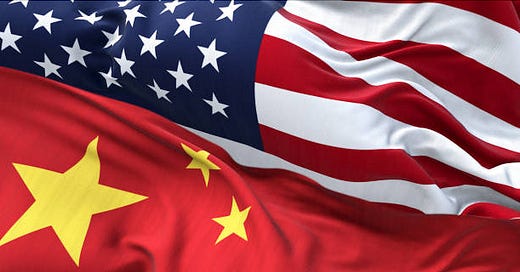#30: How the U.S. and China Can Continue Fighting Climate Change Despite Trump
As Trump aggressively rejects climate action, U.S.-China climate collaboration once again falls onto the shoulders of companies, academia, and local governments.
In this week’s newsletter, Angel Hsu, associate professor at the University of North Carolina at Chapel Hill, delves into the rapidly deteriorating landscape of climate action in the U.S. since Donald J. Trump’s return to office, and what this means for climate cooperation with China.
Angel, who was recently named a Lead Author for the upcoming IPCC Special Report on Climate Change and Cities, shared during a recent public panel that her own academic work has already taken a hit from the Trump administration’s relentless attacks on climate science and public institutions.
Having been an active participant in Track II dialogues between non-state actors, she has closely witnessed the ups and downs of U.S.-China climate cooperation. Speaking from her experience, Angel argues that businesses, local governments, academia, and civil society – who “saved the day” during Trump’s first term – must step up. Amid Trump’s sweeping efforts to reject climate actions, they need to employ even greater creativity to sustain momentum and drive climate cooperation between the world’s two largest carbon-emitting countries.
It’s easy to conclude that, without sustained and strengthened subnational cooperation, the U.S. stands to lose. But clearly, there’s no winner should the situation continue to deteriorate. The next U.S.-China High-Level Event on Subnational Climate Action will be held in China. As Angel warns, if U.S. subnational actors, out of fear for political repercussions, choose to avoid attending, the U.S.-China relationship would lose a rare oasis of cooperation in its desert of distrust.
China’s businesses and cities would miss a valuable opportunity to renew their commitments and rebuild confidence, especially as the latest Chinese Government Work Report once again sidelines environmental and climate targets. And Chinese academia and civil society – already constrained by tightening restrictions on international collaboration – would lose crucial platforms to showcase their work and build connections.
I hope you enjoy this edition of the newsletter. Remember to read our special roundtable on the U.S., China, and climate in Trump 2.0. If you’d like to write for us, drop us an email at contact@shuangtan.me.
Analysis: How the U.S. and China Can Continue Fighting Climate Change Despite Trump
As Trump aggressively rejects climate action, U.S.-China climate collaboration once again falls onto the shoulders of companies, academia, and local governments.
Edited by Hongqiao Liu and Kevin Schoenmakers
On November 15, 2023, Presidents Xi Jinping and Joe Biden walked through the famed Filoli Garden near San Francisco, their smiles symbolizing a warmer, more optimistic phase in U.S.-China relations on climate change. A few days earlier, their respective climate envoys had brokered a broad bilateral agreement on climate cooperation called the Sunnylands Statement.
Fast forward nearly two years, and this sunny image feels distant. Donald J. Trump, now back in office, has withdrawn the United States from the Paris Agreement for the second time and paused billions of dollars in clean energy funding allocated through the Inflation Reduction Act (IRA). Escalating tariffs and retaliatory measures between the U.S. and China have further strained relations, severely undermining prospects for future dialogue or collaboration. And the Sunnylands Statement, once a milestone marking the resumption of U.S.-China climate cooperation after a yearlong freeze in bilateral climate dialogue following Nancy Pelosi’s Taiwan visit, has since been archived from the U.S. State Department’s website.
During Trump’s first term, subnational actors – city and regional governments, businesses, and universities – stepped up to fill the void left by federal disengagement. Facing even stronger setbacks this time around, will a new, reinvigorated bottom-up movement emerge to sustain and advance climate action in the world’s two biggest greenhouse gas emitters?
Facing even stronger setbacks this time around, will a new, reinvigorated bottom-up movement emerge to sustain and advance climate action in the world’s two biggest greenhouse gas emitters?
Subnationals saved the day during Trump 1.0
History offers a glimmer of hope. Under the first Trump administration, the United States’ withdrawal from the Paris Agreement galvanized a countercurrent to federal climate inaction. Nearly 4,000 American mayors, governors, business leaders, and academic institutions rallied under the “We Are Still In” movement. Their climate pledges and actions – varying from scaling up renewable energy to capacity building – were able to sustain momentum and led to emission reduction despite the lack of federal climate policy.
They also demonstrated the power of decentralized climate diplomacy. A key moment was the 2018 Global Climate Action Summit, hosted by then-California Governor Jerry Brown and former New York City Mayor Michael Bloomberg. The summit saw one of the largest overseas Chinese delegations, including Chinese policymakers, provincial and municipal representatives, NGOs, and academics, engage in climate collaboration with their U.S. counterparts. California and Chinese partners reached over a dozen Memorandums of Understanding (MOUs) during the summit, along with a surge of corporate commitments. Brown’s subsequent visit to China further underscored the pivotal role of subnational governments in sustaining international climate cooperation.
Support Shuang Tan
Shuang Tan is an independent initiative dedicated to tracking China’s energy transition and decarbonization.
The newsletter is curated, written, and edited by Hongqiao Liu, with additional editing by Kevin Schoenmakers.
Even when the Biden administration resumed diplomatic relations with China on climate change, subnational governments’ continuous efforts acted as neutral territory for collaboration amid rising geopolitical tensions. The Sunnylands Statement highlighted their special role, emphasizing the importance of city- and region-level partnerships for advancing climate action, particularly in areas where Chinese companies and local governments have been leading, including offshore wind development, EV adoption, and charging infrastructure.
California Governor Gavin Newsom, San Francisco Mayor Breed, and a bipartisan delegation of mayors from the Mississippi River Delta all traveled to China in 2023. In May 2024, the California-China Climate Institute convened another summit, fulfilling the Sunnylands commitment to hold the first U.S.-China High-level Event on Subnational Climate Action.
Is another ‘We Are Still In’ moment possible?
Today, the “We Are Still In” movement, rebranded as the “America Is All In” coalition during the Biden administration, remains committed to fulfilling the country’s obligations under the Paris Agreement. However, U.S. subnational actors now face a far more challenging landscape. With inflation, escalating tariffs, and the second Trump administration’s sweeping efforts to reshape the federal government dominating political discourse, climate action risks being sidelined at all levels.
Already, Trump’s moves against climate action this year have been wider in scope than those of his first time in office. His administration has moved to defund basic research on climate science, slashing budgets for the National Oceanic and Atmospheric Administration (NOAA), restricting the capacity of the National Science Foundation (NSF), and even withdrawing support for American leadership in the IPCC’s Working Group III on climate mitigation.
The concern is particularly acute given the looming threats of rolling back IRA funding, which served as a financial backbone of subnational climate action under the Biden administration. If that weren’t enough, the administration is also poised to limit local governments’ ability to advance key climate strategies, such as expanding EV charging infrastructure.
While China is likely to uphold this commitment, it is highly uncertain whether U.S. subnational leaders will be able – or willing – to participate.
According to the Sunnylands Statement, it is China’s turn to host the next subnational climate summit. While China is likely to uphold this commitment, it is highly uncertain whether U.S. subnational leaders will be able – or willing – to participate. The rising anti-China sentiment within the U.S. administration may make it less politically salient for subnational governments to engage openly with their Chinese counterparts.
What’s Next?
Despite the pendulum swinging back toward inaction in the U.S., the climate crisis won’t wait. The next phase of U.S.-China climate collaboration demands greater creativity from subnational actors and a renewed emphasis on shared priorities, grounded in a pragmatic approach that clearly outlines the tangible benefits for both countries.
As this new era unfolds, the table is turning: the U.S. now has much to learn from China in key areas of climate action. From EVs to battery storage, solar PV, and notably offshore wind, China dominates global capacity, while the U.S. is struggling to catch up.
The next phase of U.S.-China climate collaboration demands greater creativity from subnational actors and a renewed emphasis on shared priorities, grounded in a pragmatic approach that clearly outlines the tangible benefits for both countries.
Climate impacts and resilience, an untapped area in existing subnational cooperation, is ripe for mutual benefit. At China’s recent Two Sessions parliamentary meeting, government work reports highlighted the rising threat of extreme weather, particularly floods and heat waves. Similarly, the U.S. is grappling with intensifying climate disasters, from record-breaking heat waves to catastrophic wildfires and hurricanes.
Given these shared vulnerabilities, collaboration in areas such as climate adaptation strategies, disaster preparedness, and resilient infrastructure presents a clear opportunity. With the Trump administration’s recent cuts to the Federal Emergency Management Agency (FEMA) budget, local governments now face greater pressure to take the lead on disaster relief, creating an added incentive to align with best practices and strengthen resilience efforts.
Another essential step forward is broadening subnational climate cooperation beyond the two countries. Academics, non-profit organizations, and philanthropic groups are already exploring a Pacific Climate Dialogue aimed at expanding engagement with other East Asian countries. This initiative would ease the pressure that bilateral U.S.-China engagement puts on American and Chinese subnational actors, while forging a broader, multilateral collaboration on shared climate risks.
Get in touch
I hope you enjoy this newsletter. Share your thoughts in the comments.
If you’d like to write for Shuang Tan, republish our articles, or submit a testimonial, email us at contact@shuangtan.me.
Until next week,
Hongqiao








As President Biden smiled and chatted with President Xi, he was increasing import tariffs on Chinese EVs, solar panels and batteries. Biden enlisted Japan and Australia to help “contain China”. Biden tried to lobby the British to boycott China’s fast rail technology. And Biden intensified US efforts to prevent China from getting AI, from making advanced chips, and Biden put outright bans on Chinese products, claiming that China was a threat to our national security.
The effort to oppose China’s role in industries which help our climate is sadly bipartisan.